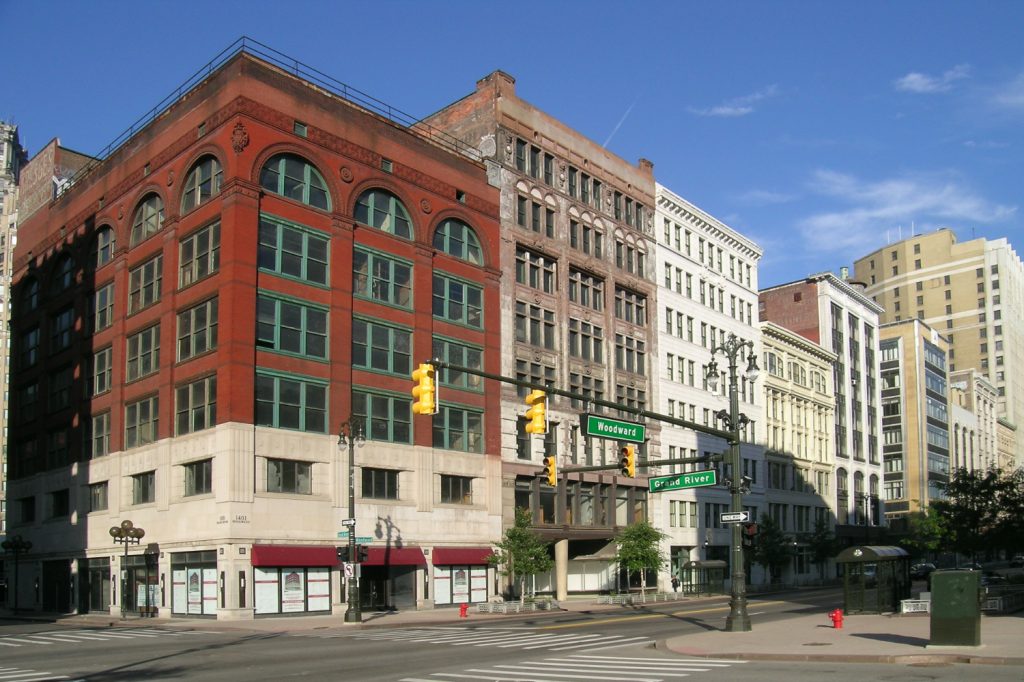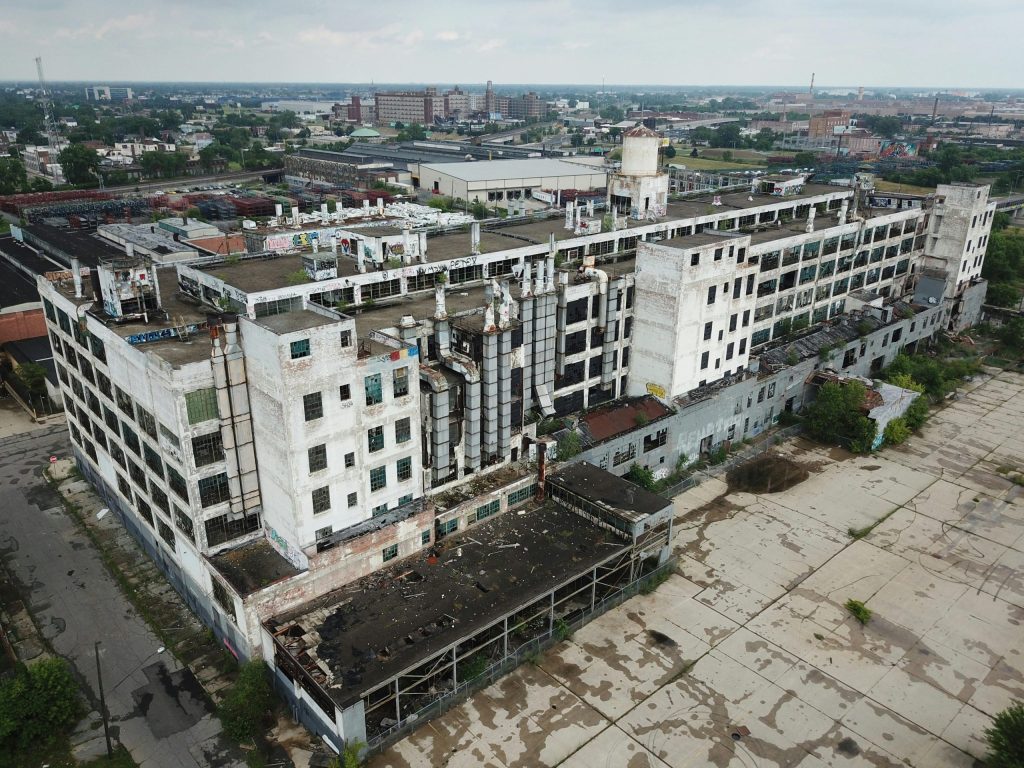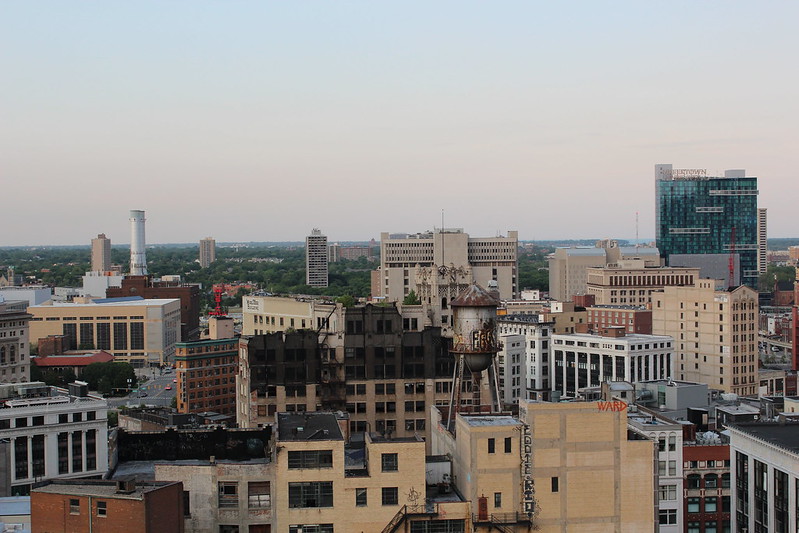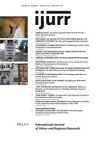Detroit has often been described as a metaphor for the modern American city—reflective of the births, deaths and afterlives of industrial urbanization; emblematic of the ways that racial injustice and its accordant inequalities, forms of segregation, and methods of political disenfranchisement, have made and remade the U.S. urban landscape.
With this year’s AAG located in the Motor City, we take this opportunity to reflect on what is both distinctive about Detroit and how its conditions, contestations and future making projects can help us think more broadly and more deeply about structures and processes of capitalist urbanization. We invite you to think with us and read (free of charge for the next 90 days) a subset of the rich articles and book reviews we have published on Detroit since the early 1980s.

1401–1449 Woodward Avenue in Detroit, Michigan showing contributing properties to the Lower Woodward Avenue Historic District (photo by Andrew Jameson, July 2008, CC-BY-SA 3.0)
Reading these 20 pieces together offers something of a historical narrative, a longitudinal picture of America’s urban crisis. The first piece in the set, published in the mid-1980s, helps us see how the crisis was viewed at the time, as one of ‘high unemployment, growing demands on the municipal budget and a shrinking revenue base’ (Trachte and Ross, p. 186). But while prevailing wisdom suggested that Detroit’s decline was cyclical and its fortunes would reverse once America’s automobile industry recovered, this piece demonstrates that structures of monopoly capitalism and processes of globalization were dislodging industries from their urban locations. Detroit’s recovery, the piece argued, would require a fundamentally ‘restructured local economy’ and revised relations between workers, the local state, and increasingly globalized industries.

Drone Shot of Fisher Body Plant 21 in Detroit, Michigan (photo by Blake, July 2019: https://tinyurl.com/2b3emsjw)
The next piece published thirty years later by Dana Kornberg (winner of IJURR’s 2016 Best Article prize), looks back at the structural origins of Detroit’s challenges to recenter the local state, and its role as a provider of municipal services, to help explain the institutional, economic and racial isolation of Detroit from its wealthier, whiter suburbs and the territorial stigmatization that fueled further white flight and economic disinvestment.
The third piece, meanwhile, by Kyle T. Mays—who will be delivering the 2025 Antipode Lecture at the AAG on Wednesday afternoon—published as part of an Interventions collection on Indigenous Urbanisms, draws questions of resistance back into the frame, highlighting examples of Indigenous expressive culture that, in solidarity with African Americans, are contesting dispossession in this predominantly Black city.

Midtown Detroit (photo by Ann Millspaugh, July 2012: https://tinyurl.com/yr8tbwbt)
These three elements—race, capitalism and resistance—and their entanglements over the past forty years, run through the entire collection and help us think more deeply and more broadly about cities and about Detroit. Please read and engage with the full set of articles, which help us reflect on, among other themes, tactics of racialized policing and defensive architecture used to enforce racial segregation; representations of nature and ruin, the failures of image-led planning, and market-driven placemaking projects that have underlay Detroit’s revitalization efforts, and pressing questions of how to maintain community benefits and retain space for Detroit’s older adults in a gentrifying downtown. As we visit Detroit for this year’s AAG, we encourage you to revisit these insights and reflections on this modern American city.
Liza Weinstein
IJURR Editor
March 2025
ARTICLES (free to access for 90 days)
The crisis of Detroit and the emergence of global capitalism
Kent Trachte and Robert Ross (1985)
The Structural Origins of Territorial Stigma: Water and Racial Politics in Metropolitan Detroit, 1950s–2010s
Dana Kornberg (2016)
THE CITIES WE CALL HOME: Indigeneity, Race and Settler-Colonial Urbanisms
Kyle T. Mays (2023)
Emerging urban policies in a slow‐growth economy: Conservative initiatives and progressive responses in the US
Norman J. Glickman (1981)
Lipstick on the Gorilla: The Failure of Image‐led Planning in Coleman Young’s Detroit
William J.V. Neill (1995)
Enforcement Mechanisms Discouraging Black–American Presence in Suburban Detroit
Tim Bates and David Fasenfest (2005)
Guerrilla‐style Defensive Architecture in Detroit: A Self‐provisioned Security Strategy in a Neoliberal Space of Disinvestment
Kimberley Kinder (2014)
Reappearance of the Public: Placemaking, Minoritization and Resistance in Detroit
Alesia Montgomery (2016)
Technologies of Translocality: Vegetables, Meat and Dresses in Arab Muslim Detroit
Kimberley Kinder (2016)
Post‐Industrial Imaginaries: Nature, Representation and Ruin in Detroit, Michigan
Nate Millington (2012)
Weeds, Pheasants and Wild Dogs: Resituating the Ecological Paradigm in Postindustrial Detroit
Paul Draus and Juliette Roddy (2018)
The Shrinking City as a Growth Machine: Detroit’s Reinvention of Growth through Triage, Foundation Work and Talent Attraction
Lisa Berglund (2020)
MISSING OLDER ADULTS IN A GENTRIFYING DOWNTOWN: Detroit’s Rebrand for a Young and Talented Pool of Residents
Lisa Berglund, Julie Mah, Tam Perry and Patricia Rencher (2022)
DETROIT’S FIGHTS FOR COMMUNITY BENEFITS: Exploring the Challenges and Strategies of Securing Community Benefits Agreements in a Legacy City
Lisa Berglund & Jodi Miles (2025)
BOOK REVIEWS
George Galster 2012: DRIVING DETROIT: The Quest for Respect in the Motor City. Philadelphia: University of Pennsylvania Press
Robert Beauregard (2014)
Montgomery, Alesia M. 2020: Greening the Black Urban Regime: The Culture and Commerce of Sustainability in Detroit. Detroit, MI: Wayne State University Press
Joshua Akers (2021)
Kimberley Kinder 2016: DIY Detroit: Making Do in a City without Services. Minneapolis: University of Minnesota Press
Samuel Walker (2017)
BOOK REVIEW ESSAY
